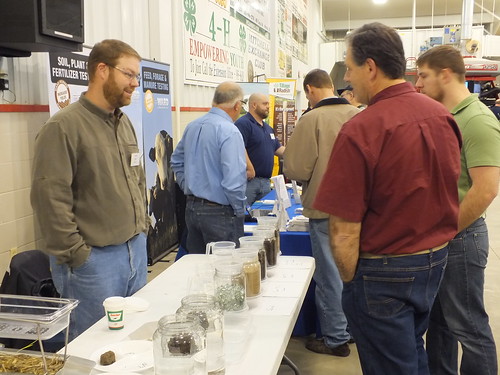Visiting Dad and Bev (October 2012)
Check out these family meals images:
Visiting Dad and Bev (October 2012)

Image by cseeman
Photos of Dad (Bernie) and Bev on Saturday October 13, 2012 and Sunday October 14, 2014. The pictures were at Peet’s in Antioch, California, at the Edgewater Covenant Church in Pittsburg, and two meals at their favorite restaurant (EJ Phair) in Pittsburg, California.
2014 Thanksgiving Meal

Image by U.S. Army Garrison Casey
Army leaders express gratitude to Service members, civilian employees and families by serving a traditional Thanksgiving meal Nov. 27. Warrior Country dining facilities were decorated in seasonal colors, baked goods and a cornucopia of fruit and vegetables.
131128-A-TN121-011

Image by 210th Field Artillery Brigade
CAMP CASEY, South Korea – Soldiers and Families from 210th Fires Brigade, 2nd Infantry Division share a Thanksgiving feast at the Thunder Inn on Camp Casey, South Korea Nov. 28, 2013. The dining facility staff cooked traditional Thanksgiving dishes and created themed displays to compete in the 2ID Thanksgiving Culinary Arts Competition. Senior leaders from the Thunder Brigade served the meal to honor Soldiers and Family members, the centerpiece of the brigade and the strength of the Army. (U.S. Army photo by Capt. Kelly E. McKenzie, 210th Fires Brigade Public Affairs)
Thanksgiving 2012
Check out these family meals images:
Thanksgiving 2012

Image by mhaithaca
0896 2009 Coffman Family Reunion June 28, 2009

Image by bsabarnowl
2009 Coffman Family Reunion
Montezuma Brethren Church
June 28, 2009
Family chicken AUD15, 3 small salads AUD15 – McKinnon Free Range Charcoal Chicken

Image by avlxyz
Julia’s dad took a walk to McKinnon and came back with dinner!
Nice smoky chicken, roasted on a bed of charcoal.
coleslaw, mixed bean salad, Greek salad
Big Apple BBQ Block Party 2012
Check out these barbecue foods images:
Big Apple BBQ Block Party 2012

Image by joshbousel
Targ Śniadaniowy Krakowskie Przedmieście

Image by FEMBI
Z okazji festiwalu Transkaukazja Targ Śniadaniowy zawitał także w okolice Starego Miasta.
Big Apple BBQ Block Party 2012
A few nice barbecue foods images I found:
Big Apple BBQ Block Party 2012

Image by joshbousel
dinner time

Image by mccun934
some simple pork chops for a Monday night.
the sun quickly disappeared about 10 minutes after this shot and the temp dropped like a rock
first bbq of the spring

Image by rosipaw
Can you smell the aromatic smoke?
52 in 2014 – #48 fog, mist or smoke
2012 Soil Health Information Day, Mitchell, SD
Some cool healthy food choices images:
2012 Soil Health Information Day, Mitchell, SD

Image by NRCS SD
Vender Area
FOCUS FOR AG FUTURE: SOIL BIOLOGY AS “NEW FRONTIER”
NATURAL RESOURCES CONSERVATION SERVICE (NRCS), Pierre, SD, December 14, 2012—The inherent and dynamic qualities of soil were in the spotlight at the Soil Health Information Day held December 11, 2012 in Mitchell, SD. The event attracted over 230 people to hear regional and national agriculture and natural resources speakers.
Ruth Beck, SDSU Extension Agronomy Field Specialist, Pierre, says “One goal with the event was to help people learn ways to manage soil that improve the soil function. Although we can’t change the inherent qualities of the soil in our yards, fields and pastures, we can make management choices that affect the amount of organic matter, structure, depth, water and nutrient-holding capacity—the indicators of the health of a soil.”
“While the physical and chemical properties of soil have long been a main factor for land use planning, we are now getting an understanding of the biology happening beneath our feet,” says Colette Kessler, Public Affairs Specialist with the USDA Natural Resources Conservation Service (NRCS), Pierre. “Thanks to technology advances in microscopes and other equipment, our ‘understanding’ of the science of soil, biology in particular, has grown more in the last three years than the last 30,” she explains.
Two Alpena area farmers were enlisted to kick off the day demonstrating water infiltration with Ray Archuleta, Conservation Agronomist, from the NRCS East National Technical Center, Greensboro, NC. “Look at this…it isn’t a problem of run-off; we have an infiltration problem,” said Archuleta as the audience watched him work through the soil experiment. “Ray the Soil Guy” got to the ‘root’ of everyone’s questions with his presentation “Healthy Soils Make Healthy Profits.” Archuleta is passionate about soil health and his passion is infectious. He specializes in soil biology/ecology and diversity approaches for agro-ecosystem sustainability. “Understanding the biology—the microbes—in the soil is the ‘next step’ for farmers and ranchers,” says Archuleta. Every operation is unique. He outlined how to use above-ground management, such as crop rotations, cover crops, and reducing tillage as tools to manipulate the soil biology for a more sustainable system.
“A healthy soil is not compacted. It has structure with macro pores that allow water to infiltrate down into the profile,” Archuleta explained earlier. “When I pick up a shovelful of soil, it should look like cottage cheese.” Jim Hoorman, Ohio State University, via webinar, outlined their university research findings and the economics of using mixes of cover crops to improve the problem of compacted soils. Mixtures are better for addressing compaction than using a single cover crop species. Hoorman explained that disturbances, like tillage, can destroy pore structure in a soil. Good pore structure is very important, allowing the soil to breathe and move water.
“Healthy soil regulates water well,” explained Paul Jasa, Extension Engineer, University of Nebraska-Lincoln. Soil and residue management helps control where rain, snowmelt and irrigation water goes. “Field after field,” he says, “Residue drives the crop. Buffers are good, but a ‘band-aid;’ fix the soil in the field with residue and keep your water,” says Jasa. “Go out with a spade and see for yourself how your soil is handling water.”
Internationally known Dr. Dwayne Beck, Manager, SDSU Dakota Lakes Research Farm near Pierre, encourages producers to mimic nature, “I’ve learned more from observing nature than trying to change it.” Crop residue helps improve the soils balance of nutrients like nitrogen and phosphorus. Beck’s presentation outlined ‘Catch and Release Nutrients’ and working with natural cycles to maximize crop production. “Plant roots are ‘hot spots’ for biological activities like nutrient cycling and soil aggregate stability,” says Beck. Both living roots, and the dead or dying roots, improve water infiltration and break up compacted soils. An abundance of roots helps to stabilize biological activities below ground, making more nutrients and water available to plants.
A common theme recommended throughout the day was for people to get out in their yards, fields and pastures with a shovel. “If we dig a little, we can learn a lot,” says Kessler, “We can better understand how healthy soil should look and smell, and how healthy soil should feel in our hands.” By the year 2050, Earth’s population is expected to reach 9 billion. Keeping every inch of our soil healthy will be essential as farmers and ranchers work to produce as much food and fiber in the next 40 years as they have in the last 500.
Photos showing Soil health can also be found at: www.flickr.com/photos/87743206@N04/
2012 Soil Health Information Day, Mitchell, SD

Image by NRCS SD
Vender Area
FOCUS FOR AG FUTURE: SOIL BIOLOGY AS “NEW FRONTIER”
NATURAL RESOURCES CONSERVATION SERVICE (NRCS), Pierre, SD, December 14, 2012—The inherent and dynamic qualities of soil were in the spotlight at the Soil Health Information Day held December 11, 2012 in Mitchell, SD. The event attracted over 230 people to hear regional and national agriculture and natural resources speakers.
Ruth Beck, SDSU Extension Agronomy Field Specialist, Pierre, says “One goal with the event was to help people learn ways to manage soil that improve the soil function. Although we can’t change the inherent qualities of the soil in our yards, fields and pastures, we can make management choices that affect the amount of organic matter, structure, depth, water and nutrient-holding capacity—the indicators of the health of a soil.”
“While the physical and chemical properties of soil have long been a main factor for land use planning, we are now getting an understanding of the biology happening beneath our feet,” says Colette Kessler, Public Affairs Specialist with the USDA Natural Resources Conservation Service (NRCS), Pierre. “Thanks to technology advances in microscopes and other equipment, our ‘understanding’ of the science of soil, biology in particular, has grown more in the last three years than the last 30,” she explains.
Two Alpena area farmers were enlisted to kick off the day demonstrating water infiltration with Ray Archuleta, Conservation Agronomist, from the NRCS East National Technical Center, Greensboro, NC. “Look at this…it isn’t a problem of run-off; we have an infiltration problem,” said Archuleta as the audience watched him work through the soil experiment. “Ray the Soil Guy” got to the ‘root’ of everyone’s questions with his presentation “Healthy Soils Make Healthy Profits.” Archuleta is passionate about soil health and his passion is infectious. He specializes in soil biology/ecology and diversity approaches for agro-ecosystem sustainability. “Understanding the biology—the microbes—in the soil is the ‘next step’ for farmers and ranchers,” says Archuleta. Every operation is unique. He outlined how to use above-ground management, such as crop rotations, cover crops, and reducing tillage as tools to manipulate the soil biology for a more sustainable system.
“A healthy soil is not compacted. It has structure with macro pores that allow water to infiltrate down into the profile,” Archuleta explained earlier. “When I pick up a shovelful of soil, it should look like cottage cheese.” Jim Hoorman, Ohio State University, via webinar, outlined their university research findings and the economics of using mixes of cover crops to improve the problem of compacted soils. Mixtures are better for addressing compaction than using a single cover crop species. Hoorman explained that disturbances, like tillage, can destroy pore structure in a soil. Good pore structure is very important, allowing the soil to breathe and move water.
“Healthy soil regulates water well,” explained Paul Jasa, Extension Engineer, University of Nebraska-Lincoln. Soil and residue management helps control where rain, snowmelt and irrigation water goes. “Field after field,” he says, “Residue drives the crop. Buffers are good, but a ‘band-aid;’ fix the soil in the field with residue and keep your water,” says Jasa. “Go out with a spade and see for yourself how your soil is handling water.”
Internationally known Dr. Dwayne Beck, Manager, SDSU Dakota Lakes Research Farm near Pierre, encourages producers to mimic nature, “I’ve learned more from observing nature than trying to change it.” Crop residue helps improve the soils balance of nutrients like nitrogen and phosphorus. Beck’s presentation outlined ‘Catch and Release Nutrients’ and working with natural cycles to maximize crop production. “Plant roots are ‘hot spots’ for biological activities like nutrient cycling and soil aggregate stability,” says Beck. Both living roots, and the dead or dying roots, improve water infiltration and break up compacted soils. An abundance of roots helps to stabilize biological activities below ground, making more nutrients and water available to plants.
A common theme recommended throughout the day was for people to get out in their yards, fields and pastures with a shovel. “If we dig a little, we can learn a lot,” says Kessler, “We can better understand how healthy soil should look and smell, and how healthy soil should feel in our hands.” By the year 2050, Earth’s population is expected to reach 9 billion. Keeping every inch of our soil healthy will be essential as farmers and ranchers work to produce as much food and fiber in the next 40 years as they have in the last 500.
Photos showing Soil health can also be found at: www.flickr.com/photos/87743206@N04/
2012 Soil Health Information Day, Mitchell, SD

Image by NRCS SD
Jason Gilb, NRCS, Mitchell, SD
FOCUS FOR AG FUTURE: SOIL BIOLOGY AS “NEW FRONTIER”
NATURAL RESOURCES CONSERVATION SERVICE (NRCS), Pierre, SD, December 14, 2012—The inherent and dynamic qualities of soil were in the spotlight at the Soil Health Information Day held December 11, 2012 in Mitchell, SD. The event attracted over 230 people to hear regional and national agriculture and natural resources speakers.
Ruth Beck, SDSU Extension Agronomy Field Specialist, Pierre, says “One goal with the event was to help people learn ways to manage soil that improve the soil function. Although we can’t change the inherent qualities of the soil in our yards, fields and pastures, we can make management choices that affect the amount of organic matter, structure, depth, water and nutrient-holding capacity—the indicators of the health of a soil.”
“While the physical and chemical properties of soil have long been a main factor for land use planning, we are now getting an understanding of the biology happening beneath our feet,” says Colette Kessler, Public Affairs Specialist with the USDA Natural Resources Conservation Service (NRCS), Pierre. “Thanks to technology advances in microscopes and other equipment, our ‘understanding’ of the science of soil, biology in particular, has grown more in the last three years than the last 30,” she explains.
Two Alpena area farmers were enlisted to kick off the day demonstrating water infiltration with Ray Archuleta, Conservation Agronomist, from the NRCS East National Technical Center, Greensboro, NC. “Look at this…it isn’t a problem of run-off; we have an infiltration problem,” said Archuleta as the audience watched him work through the soil experiment. “Ray the Soil Guy” got to the ‘root’ of everyone’s questions with his presentation “Healthy Soils Make Healthy Profits.” Archuleta is passionate about soil health and his passion is infectious. He specializes in soil biology/ecology and diversity approaches for agro-ecosystem sustainability. “Understanding the biology—the microbes—in the soil is the ‘next step’ for farmers and ranchers,” says Archuleta. Every operation is unique. He outlined how to use above-ground management, such as crop rotations, cover crops, and reducing tillage as tools to manipulate the soil biology for a more sustainable system.
“A healthy soil is not compacted. It has structure with macro pores that allow water to infiltrate down into the profile,” Archuleta explained earlier. “When I pick up a shovelful of soil, it should look like cottage cheese.” Jim Hoorman, Ohio State University, via webinar, outlined their university research findings and the economics of using mixes of cover crops to improve the problem of compacted soils. Mixtures are better for addressing compaction than using a single cover crop species. Hoorman explained that disturbances, like tillage, can destroy pore structure in a soil. Good pore structure is very important, allowing the soil to breathe and move water.
“Healthy soil regulates water well,” explained Paul Jasa, Extension Engineer, University of Nebraska-Lincoln. Soil and residue management helps control where rain, snowmelt and irrigation water goes. “Field after field,” he says, “Residue drives the crop. Buffers are good, but a ‘band-aid;’ fix the soil in the field with residue and keep your water,” says Jasa. “Go out with a spade and see for yourself how your soil is handling water.”
Internationally known Dr. Dwayne Beck, Manager, SDSU Dakota Lakes Research Farm near Pierre, encourages producers to mimic nature, “I’ve learned more from observing nature than trying to change it.” Crop residue helps improve the soils balance of nutrients like nitrogen and phosphorus. Beck’s presentation outlined ‘Catch and Release Nutrients’ and working with natural cycles to maximize crop production. “Plant roots are ‘hot spots’ for biological activities like nutrient cycling and soil aggregate stability,” says Beck. Both living roots, and the dead or dying roots, improve water infiltration and break up compacted soils. An abundance of roots helps to stabilize biological activities below ground, making more nutrients and water available to plants.
A common theme recommended throughout the day was for people to get out in their yards, fields and pastures with a shovel. “If we dig a little, we can learn a lot,” says Kessler, “We can better understand how healthy soil should look and smell, and how healthy soil should feel in our hands.” By the year 2050, Earth’s population is expected to reach 9 billion. Keeping every inch of our soil healthy will be essential as farmers and ranchers work to produce as much food and fiber in the next 40 years as they have in the last 500.
Photos showing Soil health can also be found at: www.flickr.com/photos/87743206@N04/

